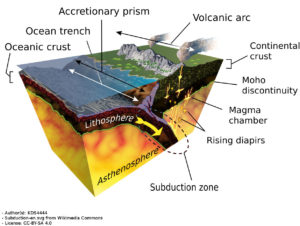Genesis 8:2
“The fountains also of the deep and the windows of heaven were stopped, and the rain from heaven was restrained;”
 There is an upper layer to the Earth’s Mantle called the Asthenosphere. This comprises of semi-molten rock. Crustal rocks of the Earth’s tectonic plates seem to almost float on this. The heavier rocks of the ocean crust float lower than the less dense rocks of the continental crust. This suggests that the rocks of the ocean floor would be older than the rocks of the continent. However, this is not the case.
There is an upper layer to the Earth’s Mantle called the Asthenosphere. This comprises of semi-molten rock. Crustal rocks of the Earth’s tectonic plates seem to almost float on this. The heavier rocks of the ocean crust float lower than the less dense rocks of the continental crust. This suggests that the rocks of the ocean floor would be older than the rocks of the continent. However, this is not the case.
Radiometric dating shows that the continental rocks are older than those in the ocean. As creationists, we tend to criticize the assumptions used to calculate ages from radiometric measurements. But our criticism of those assumptions would not alter the relative ages of the rocks. So a rock dated by a radiometric method as being, say, 200 million years old will be older than one dated by the same system as 100 million years even if we do not accept the millions of years. So we can be reasonably sure that the ocean floor rocks are older than the rocks of the continental crust.
This is a problem for evolutionary geologists, but not for creationists. Genesis tells us that the Flood began by the opening of the fountains of the deep. This suggests that huge fissures opened up on the floor of the pre-Flood ocean. Water would have come through, creating the fountains, but also magma, which would have created new ocean floors, as the old oceanic crust was subducted.
So the relative ages of the ocean floor and the continents are not a problem when our starting point is that the Bible is true.
Author: Paul F. Taylor
Prayer: Thank You, Lord, that Your word speaks to every situation and that it speaks the truth on every issue it touches. Amen.
Ref: Snelling, A.A. (2009), Earth’s Catastrophic Past, (Dallas, TX: ICR), p. 276. Image: Subduction-en.svg, Wikimedia Commons, author: KDS4444, license: CC BY-SA 4.0.
